Franz Marc
Franz Moritz Wilhelm Marc (February 8, 1880 – March 4, 1916) was a German painter and printmaker, one of the key figures of German Expressionism. He was a founding member of Der Blaue Reiter (The Blue Rider), a journal whose name later became synonymous with the circle of artists collaborating in it.
Franz Marc | |
|---|---|
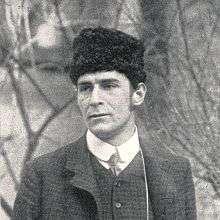 Franz Marc in 1910 | |
| Born | 8 February 1880 |
| Died | 4 March 1916 (aged 36) Braquis, France
|
| Cause of death | Killed in action |
| Nationality | German |
| Education | Academy of Fine Arts, Munich |
| Known for | Painting |
Notable work | paintings: Fate of the Animals, The Tower of Blue Horses, The Yellow Cow, Blue Horses, journal: Der Blaue Reiter |
| Movement | Expressionism |
Early life
Franz Marc was born in 1880 in Munich, the then capital of the Kingdom of Bavaria. His father, Wilhelm Marc, was a professional landscape painter; his mother, Sophie, was a homemaker and a devout, socially liberal Calvinist.
At the age of 17 Marc wanted to study theology. Two years later, however, he enrolled in the arts program of Munich University. He was first required to serve in the military for a year, after which, in 1900, he began studies instead at the Academy of Fine Arts, Munich, where his teachers included Gabriel von Hackl and Wilhelm von Diez.[1] In 1903 and 1907, he spent time in France, particularly in Paris, visiting the museums in the city and copying many paintings, a traditional way for artists to study and develop technique. In Paris, Marc frequented artistic circles, meeting numerous artists and the actress Sarah Bernhardt. He discovered a strong affinity for the work of painter Vincent van Gogh.[1] After the 1903 trip, he ceased attending the Academy of Fine Arts.
During his 20s, Marc was involved in a number of stormy relationships, including an affair lasting for many years with Annette Von Eckardt, a married antique dealer nine years his senior. He married twice, first to Marie Schnür, then to Maria Franck; both were artists.
Career
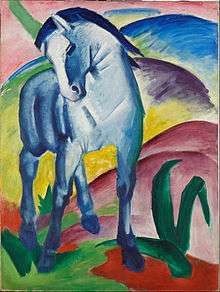
In 1906, Marc traveled with his elder brother Paul, a Byzantine expert, to Thessaloniki, Mount Athos, and various other Greek locations. A few years later, in 1910, Marc developed an important friendship with the artist August Macke. In 1910 Marc painted Nude with Cat and Grazing Horses, and showed works in the second exhibition of the Neue Künstlervereinigung (New Artists' Association) at the Thannhauser Galleries in Munich.[2]
In 1911, Marc founded the Der Blaue Reiter journal, which became the center of an artist circle, along with Macke, Wassily Kandinsky, and others who had decided to split off from the Neue Künstlervereinigung movement.
Marc showed several of his works in the first Der Blaue Reiter exhibition at the Thannhauser Galleries in Munich between December 1911 and January 1912. As it was the apex of the German expressionist movement, the exhibit also showed in Berlin, Cologne, Hagen, and Frankfurt. In 1912, Marc met Robert Delaunay, whose use of color and the futurist method was a major influence on Marc's work; fascinated by futurism and cubism, Marc created art that increasingly was stark and abstract in nature. He painted The Tiger and Red Deer in 1912 and The Tower of Blue Horses, Foxes, and Fate of the Animals in 1913.[2]
Wartime
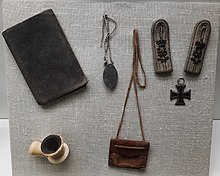
With the outbreak of World War I in 1914, Marc was drafted into the Imperial German Army as a cavalryman. By February 1916, as shown in a letter to his wife, he had gravitated to military camouflage. His technique for hiding artillery from aerial observation was to paint canvas covers in broadly pointillist style. He took pleasure in creating a series of nine such tarpaulin covers in styles varying "from Manet to Kandinsky", suspecting that the latter could be the most effective against aircraft flying at 2000 meters or higher.[3]
After mobilization of the German Army, the government identified notable artists to be withdrawn from combat for their own safety. Marc was on the list but was struck in the head and killed instantly by a shell splinter during the Battle of Verdun in 1916 before orders for reassignment could reach him.[4]
Style
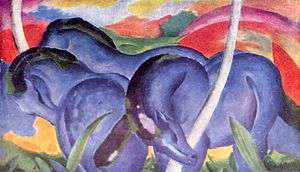
Marc made some sixty prints in woodcut and lithography. Most of his mature work portrays animals,[5] usually in natural settings. His work is characterized by bright primary color, an almost cubist portrayal of animals, stark simplicity and a profound sense of emotion. Even in his own time, his work attracted notice in influential circles. Marc gave an emotional meaning or purpose to the colors he used in his work: blue was used to portray masculinity and spirituality, yellow represented feminine joy, and red encased the sound of violence. After the National Socialists took power, they suppressed modern art; in 1936 and 1937, the Nazis condemned the late Marc as an entarteter Künstler (degenerate artist) and ordered approximately 130 of his works removed from exhibition in German museums. His painting Landscape With Horses was discovered in 2012 along with more than a thousand other paintings, in the Munich apartment of Cornelius Gurlitt whose dealer father, Hildebrand Gurlitt, was a collector of Modernist art the Nazis called "degenerate".[6]
One of Marc's best-known paintings is Tierschicksale (Animal Destinies or Fate of the Animals), which hangs in the Kunstmuseum Basel. Marc had completed the work in 1913, when "the tension of impending cataclysm had pervaded society", as one art historian noted.[7] On the rear of the canvas, Marc wrote, "Und Alles Sein ist flammend Leid" ("And all being is flaming agony").[7][8] Serving in World War I, Marc wrote to his wife about the painting, "[it] is like a premonition of this war - horrible and shattering. I can hardly conceive that I painted it."
Legacy and honors
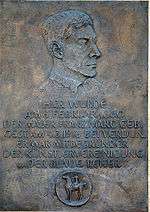
Marc's family house in Munich is marked with a historical plaque. The Franz Marc Museum opened in 1986, and his dedicated to the artist life and work. It houses many of his paintings, and also works by other contemporary artists.[9]
In October 1998, several of Marc's paintings garnered record prices at Christie's art auction house in London, including Rote Rehe I (Red Deer I), which sold for $3.3 million. In October 1999, his Der Wasserfall (The Waterfall) was sold by Sotheby's in London for $5.06 million. This price set a record for Franz Marc's work and for twentieth-century German painting.
Public collections
Among the public collections holding works by Franz Marc are:
- Museum de Fundatie, Zwolle, Netherlands[10]
- Solomon R. Guggenheim Museum, New York
- Franz Marc Museum in Kochel am See
- Lenbachhaus, Munich
Gallery
 Die gelbe Kuh, The Yellow Cow (1911)
Die gelbe Kuh, The Yellow Cow (1911)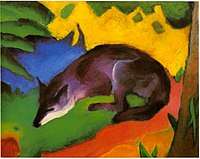 Fuchs, Fox (1911)
Fuchs, Fox (1911)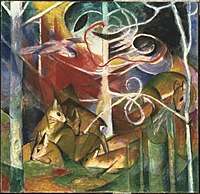 Rehe im Wald I, Deer in the Forest I (1913)
Rehe im Wald I, Deer in the Forest I (1913)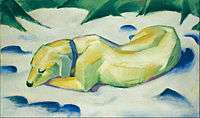 Liegender Hund im Schnee, Dog Lying in the Snow (1910–11)
Liegender Hund im Schnee, Dog Lying in the Snow (1910–11)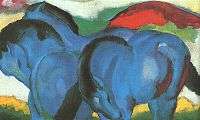 Die kleinen blauen Pferde, The Little Blue Horses (1911)
Die kleinen blauen Pferde, The Little Blue Horses (1911)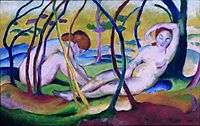 Akte unter Bäumen, Nudes under Trees (1911)
Akte unter Bäumen, Nudes under Trees (1911)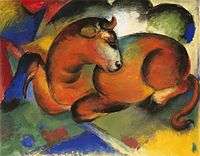 Roter Stier, Red Bull (1912)
Roter Stier, Red Bull (1912)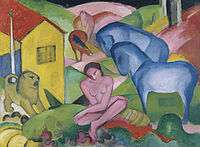 Der Traum, The Dream (1912)
Der Traum, The Dream (1912).jpg) Das Äffchen, The Little Monkey (1912)
Das Äffchen, The Little Monkey (1912)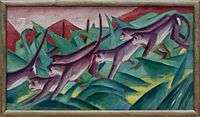 Affenfries, Monkey Frieze (1911)
Affenfries, Monkey Frieze (1911)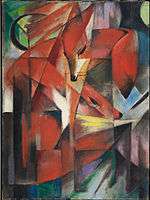 Füchse, Foxes (1913)
Füchse, Foxes (1913)_(1912).jpg) Im Regen, In the Rain (1912)
Im Regen, In the Rain (1912)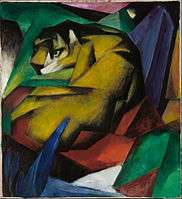 Der Tiger, The Tiger (1912)
Der Tiger, The Tiger (1912)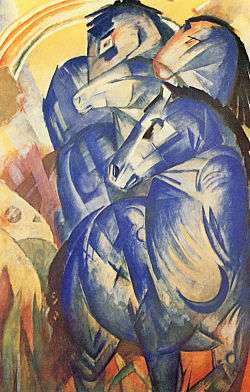
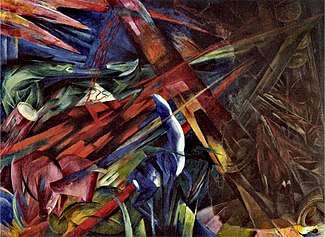 Tierschicksale, Fate of the Animals (1913)
Tierschicksale, Fate of the Animals (1913)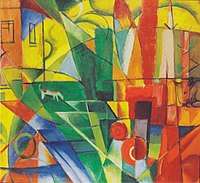 Landschaft mit Haus, Hund und Rind, Landscape with house, dog and cattle (1914)
Landschaft mit Haus, Hund und Rind, Landscape with house, dog and cattle (1914)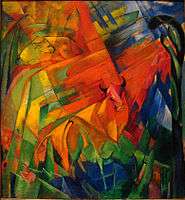 Tiere in der Landschaft, Animals in a landscape (1914)
Tiere in der Landschaft, Animals in a landscape (1914)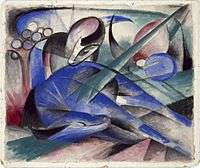 Träumendes Pferd, Dreaming Horse (1913), Solomon R. Guggenheim Museum, New York
Träumendes Pferd, Dreaming Horse (1913), Solomon R. Guggenheim Museum, New York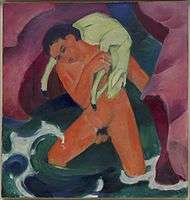 Knabe mit Lamm; Der gute Hirte, Young Boy with a Lamb; The Good Shepherd (1911), Solomon R. Guggenheim Museum, New York
Knabe mit Lamm; Der gute Hirte, Young Boy with a Lamb; The Good Shepherd (1911), Solomon R. Guggenheim Museum, New York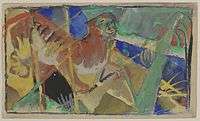 Tiger im Dschungel, Tiger in the Jungle (1912-1913), Solomon R. Guggenheim Museum, New York
Tiger im Dschungel, Tiger in the Jungle (1912-1913), Solomon R. Guggenheim Museum, New York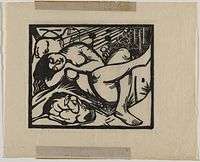 Schlafende Hirtin, Sleeping Shepherdess (1912), Solomon R. Guggenheim Museum, New York
Schlafende Hirtin, Sleeping Shepherdess (1912), Solomon R. Guggenheim Museum, New York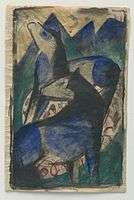 Zwei blaue Pferde, Two Blue Horses (1913), Solomon R. Guggenheim Museum, New York
Zwei blaue Pferde, Two Blue Horses (1913), Solomon R. Guggenheim Museum, New York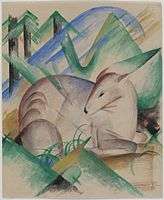 Rotes Reh, Red Deer (1913), Solomon R. Guggenheim Museum, New York
Rotes Reh, Red Deer (1913), Solomon R. Guggenheim Museum, New York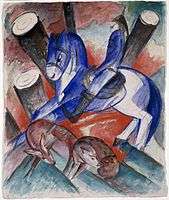 St. Julien l'Hospitalier, St. Julian the Hospitaler (1913), Solomon R. Guggenheim Museum, New York
St. Julien l'Hospitalier, St. Julian the Hospitaler (1913), Solomon R. Guggenheim Museum, New York%2C_1912%2C_NGA_139937.jpg) Versöhnung, Reconciliation (1912), National Gallery of Art
Versöhnung, Reconciliation (1912), National Gallery of Art
See also
- The Tower of Blue Horses, 1913, missing since 1945
References
- Elger, Dietmar (2002). Expressionism: A Revolution in German Art. Taschen. pp. 153–154. ISBN 9783822820421.
- Klaus H. Carl and Franz Marc, Franz Marc, Parkstone Press 2013
- Newark, Tim (2007). Camouflage. Thames and Hudson / Imperial War Museum. p. 68.
- Dantini, Michele, Modern & Contemporary Art, (Sterling Publishing Inc., 2008), 29.
- Cooper, Philip. Cubism. London: Phaidon, 1995, p. 98. ISBN 0714832502
- Kimmelman, Michael (5 November 2013). "In a Rediscovered Trove of Art, a Triumph Over the Nazis' Will". The New York Times. Retrieved 8 November 2013.
- Kleiner, Fred S. Gardner's Art Through the Ages. 2008, page 916
- Rookmaaker, Hendrik Roelof. Modern Art and the Death of a Culture. 1994, page 136
- Franz Marc Museum, Muenchen.De (German)
- http://www.collectienederland.nl/dimcon/defundatie/652
Publications
- Düchting, Hajo, Der Blaue Reiter, Taschen, Köln, 2009. ISBN 978-3-8228-5577-5
- Rosenthal, Mark, Franz Marc, Prestel, 2004. ISBN 3-7913-3094-2
- Partsch, Susanna, Franz Marc, Taschen, Köln, 2001. ISBN 978-3-8228-5644-4
External links
| Wikimedia Commons has media related to: |
| Wikiquote has quotations related to: Franz Marc |
- Gallery of Marc's work
- Links on Marc
- WebMuseum Franz Marc Page
- Franz Marc's Cats in Art
- Works by Franz Marc at LibriVox (public domain audiobooks)
